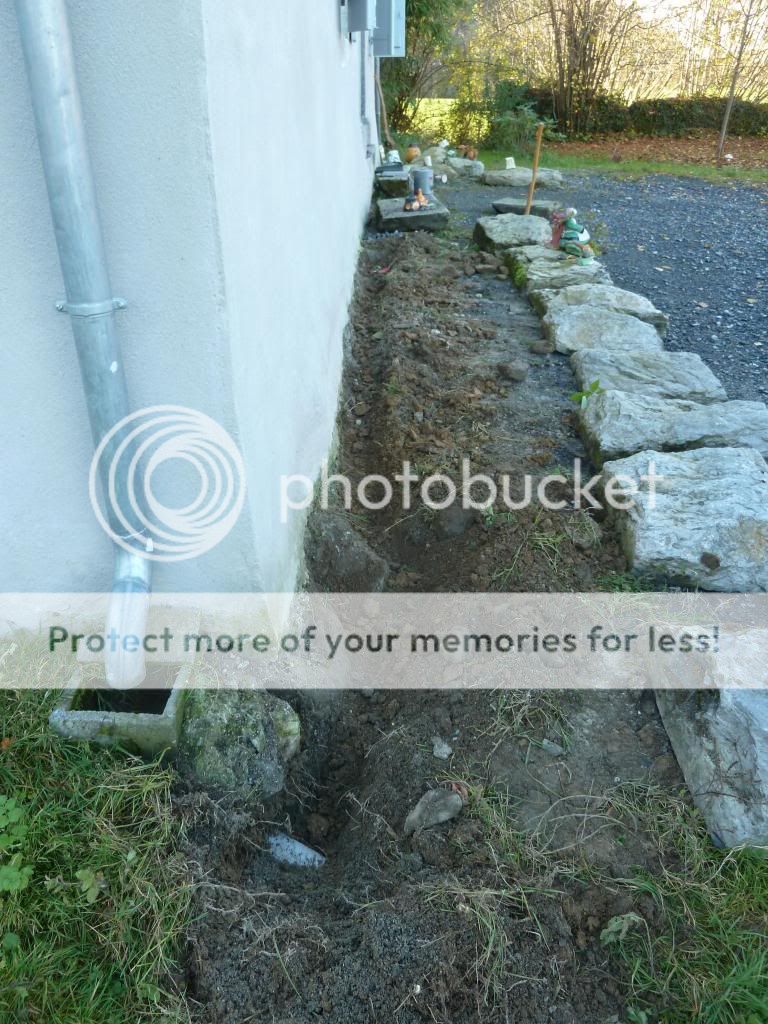- Joined
- 19 Nov 2012
- Messages
- 1
- Reaction score
- 0
- Country

Hello I am a Kiwi living in France. I have bought a old (2 story) stone farmhouse in the Pyrenees that has been rebuilt from a complete ruin about 6 years ago.
Now that weather is turning colder and wetter, we have noticed damp rising on some of the (south facing) walls. Here is a photo from the dining room;

The walls appear to be plastered rock/rubble as per this photo taken after the trim was removed;

From digging on the outside, it seems that the walls even lack a foundation, and are sitting directly on the ground (which is rocky). It could just be the the footings are not flush with the plaster on the exterior wall, but I am reluctant to undercut to see if this is the case.
I have been googling away, but have not found too much except advetorials for companies wishing to push chemical barriers. I am more convinced however by the approach of exposing the foundation to air to allow it to dry out, as per this article;
http://www.buildingconservation.com/articles/risingdamp/risingdamp.htm
Inspired by that article, I have begun (not finished yet, plan on making it deeper) digging a small trench alongside the house, as per this snapshot;

So, my first questions, are;
-- Are there any good resources on the Interned that deal with this problem?
-- Is my approach sound?
-- Should I line the trench with landscaping fabric and gravel?
-- How necessary is it to drain this trench away? I don't *think* it will fill up with water, as it is relatively sheltered by the house, and I believe the major objective of the trench is not drainage so much as ventilation for the sub ground footings.
I have an existing storm water drain (visible in bottom of last photo, I don't know where it goes), and am wondering if there is any good way to tap into that with my trench (since the pipe will be well underground by the time my 10cm deep sloping trench reaches it, I cannot figure out any way of connecting into it without the creating erosion around the solid drain and the open(ish) trench.
Failing that, I might try extending the trench with a "french drain" across our gravel parking area.
-- Any suggestions for how to handle all this?
Thanks for the help
Bruce.
Now that weather is turning colder and wetter, we have noticed damp rising on some of the (south facing) walls. Here is a photo from the dining room;

The walls appear to be plastered rock/rubble as per this photo taken after the trim was removed;

From digging on the outside, it seems that the walls even lack a foundation, and are sitting directly on the ground (which is rocky). It could just be the the footings are not flush with the plaster on the exterior wall, but I am reluctant to undercut to see if this is the case.
I have been googling away, but have not found too much except advetorials for companies wishing to push chemical barriers. I am more convinced however by the approach of exposing the foundation to air to allow it to dry out, as per this article;
http://www.buildingconservation.com/articles/risingdamp/risingdamp.htm
Inspired by that article, I have begun (not finished yet, plan on making it deeper) digging a small trench alongside the house, as per this snapshot;

So, my first questions, are;
-- Are there any good resources on the Interned that deal with this problem?
-- Is my approach sound?
-- Should I line the trench with landscaping fabric and gravel?
-- How necessary is it to drain this trench away? I don't *think* it will fill up with water, as it is relatively sheltered by the house, and I believe the major objective of the trench is not drainage so much as ventilation for the sub ground footings.
I have an existing storm water drain (visible in bottom of last photo, I don't know where it goes), and am wondering if there is any good way to tap into that with my trench (since the pipe will be well underground by the time my 10cm deep sloping trench reaches it, I cannot figure out any way of connecting into it without the creating erosion around the solid drain and the open(ish) trench.
Failing that, I might try extending the trench with a "french drain" across our gravel parking area.
-- Any suggestions for how to handle all this?
Thanks for the help
Bruce.

